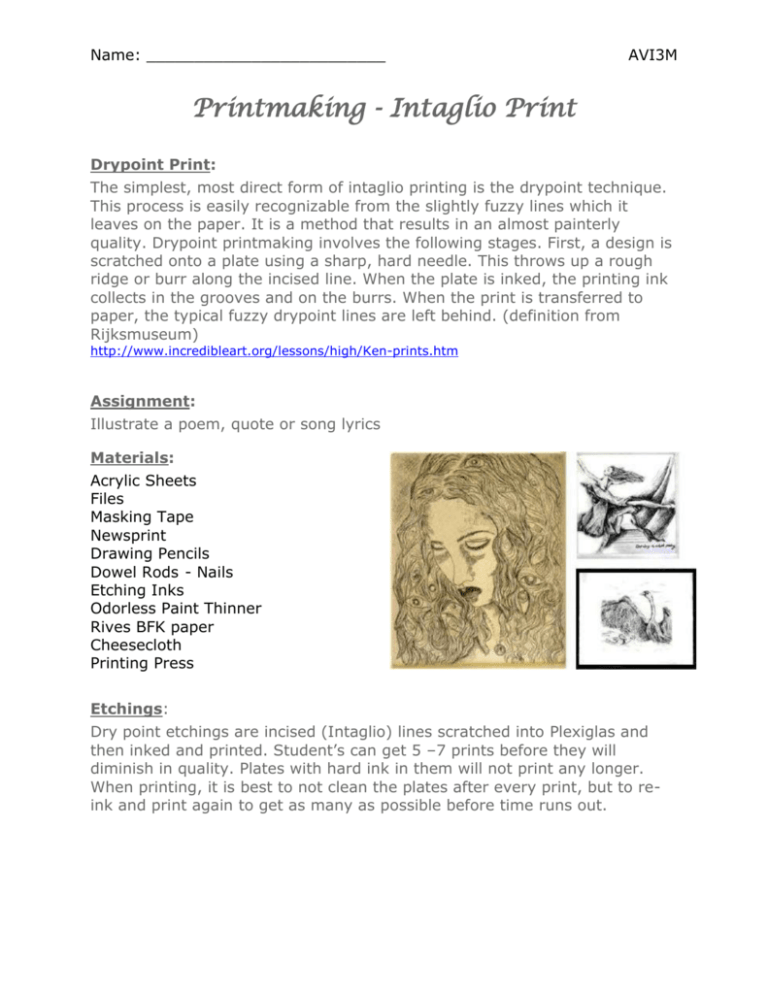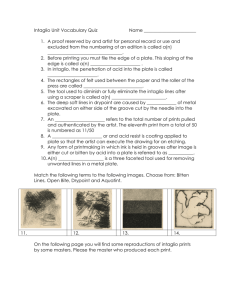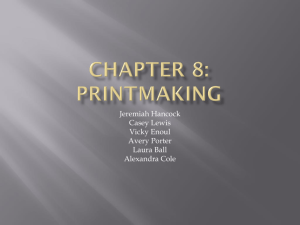
Name: _________________________
AVI3M
Printmaking - Intaglio Print
Drypoint Print:
The simplest, most direct form of intaglio printing is the drypoint technique.
This process is easily recognizable from the slightly fuzzy lines which it
leaves on the paper. It is a method that results in an almost painterly
quality. Drypoint printmaking involves the following stages. First, a design is
scratched onto a plate using a sharp, hard needle. This throws up a rough
ridge or burr along the incised line. When the plate is inked, the printing ink
collects in the grooves and on the burrs. When the print is transferred to
paper, the typical fuzzy drypoint lines are left behind. (definition from
Rijksmuseum)
http://www.incredibleart.org/lessons/high/Ken-prints.htm
Assignment:
Illustrate a poem, quote or song lyrics
Materials:
Acrylic Sheets
Files
Masking Tape
Newsprint
Drawing Pencils
Dowel Rods - Nails
Etching Inks
Odorless Paint Thinner
Rives BFK paper
Cheesecloth
Printing Press
Etchings:
Dry point etchings are incised (Intaglio) lines scratched into Plexiglas and
then inked and printed. Student’s can get 5 –7 prints before they will
diminish in quality. Plates with hard ink in them will not print any longer.
When printing, it is best to not clean the plates after every print, but to reink and print again to get as many as possible before time runs out.
Name: _________________________
AVI3M
Steps:
1. Make a pencil sketch of the composition, including shades, shadows, and
gradations.
2. Use a file and file down the edges and corners of the Plexiglas, use a fine
file to get most of it and 400-grit wet/dry paper to make it smooth. Bevel
the edges and file down to the base of the Plexiglas.
3. Place the sketch under the Plexiglas with tape and by using a nail into a
dowel and sharpened with the files, start to scratch the Plexiglas, creating
lines with a rough edge. You must hear it scratch the surface.
4. With daubers and etching ink (general chemical), rub (with great
pressure), the etching ink into the incised lines covering the entire surface
with ink. Use cheesecloth and lightly rub the cloth over the print surface
taking off the wasted ink. Rub the cheesecloth in one direction so as to not
wipe too far down into the lines and try to rub across most of the lines.
5. Use q-tips and such to clean small areas. Soak some Rives BFK paper for
at least 10 min. Run through an etching press at moderate pressure with 2
blankets.
6. Clean up is done with paint thinner, outside and a clean rag is used.
Leave no film in the lines.
Extensions:
Add Chine Collé. This paper (Tissue paper work well) - cut to fit shapes of
plate - or abstract. Here is the ArtLex definition for Chine Collé: A technique
in printmaking in which an impression is made on a surface at the same time
as its opposite side is adhered to a heavier support in the procedure. This
process permits printing onto such delicate materials as rice paper and linen,
allowing the plate to produce finer details in the printed image than would
normally be possible. Once an adhesive (traditionally a solution of rice flour
and water) has been applied to the reverse side of the lighter material, the
heavier support (typically, such a heavyweight paper as is typically used in
printmaking) is placed upon it. In applying the pressure of the press, the
reverse side of the lighter material adheres to the support as an image is
simultaneously printed onto its obverse side. (pr. sheen koh-lay)
Name: _________________________
AVI3M
Assessment: Rubric adapted from Marianne Galyk
Assessment Rubric
Student Name:
Class Period:
Assignment: Dry Point Engraving Print
Date Completed:
Circle the number in pencil that
best shows how well you feel
that you completed that
criterion for the assignment.
Excellent
Good
Average
Needs
Improvement
Criteria 1 – drawing for print illustrating poem, quote or song
lyrics
10
9–8
7
6 or less
Criteria 2 – engraving of plate cross hatching/textures to show
range of values
10
9–8
7
6 or less
Criteria 3 – pulls prints of
consistent quality - prints an
edition - signs correctly
10
9–8
7
6 or less
Criteria 4 – Effort: took time to
develop idea & complete
project? (Didn’t rush.) Good use
of class time?
10
9–8
7
6 or less
Criteria 5 – Craftsmanship –
Neat, clean & complete? Skillful
use of the art tools & media?
10
9–8
7
6 or less
Total: 50 x 2 = 100
(possible points)
Grade:
Rate
Yourself
Your
Total
Teacher’s
Rating
Teacher
Total
Student Comments:
____________________________________________________
____________________________________________________
____________________________________________________
____________________________________________________
____________________________________________________
Teacher Comments:
____________________________________________________
____________________________________________________
____________________________________________________
____________________________________________________
____________________________________________________
Name: _________________________
AVI3M
Vocabulary:
Chine Collé
A method of printing in which an image is printed on a thin sheet of paper
and the thin sheet is mounted on a backing sheet during a single pass
through the press. The term also describes the process of using a press to
mount paper or other collage material such as cloth to a backing sheet,
sometimes with printing on it.
Drypoint
A way of drawing directly into an intaglio plate without using acid. Any
abrasive or invasive mark can be a drypoint mark, but generally the artist
draws into a metal plate with a sharp tool called a needle. The displaced
metal clings to the lines in what is called a burr. The burr is mostly above
the surface of the plate and holds ink irregularly. A printed drypoint line is
more or less fuzzy depending on how the plate is wiped.
Edition
The prints of any particular image that are offered for sale. Editions normally
are printed from plates made to hold ink in the same way each time they are
inked. Consequently, prints in an edition (even though printed by hand) are
very similar to one another, if not exactly the same. Each limited edition
print conventionally bears a fractionlike designation, with the number of
prints in the edition on the bottom of a slash mark, and the serial number of
the particular impression on the top. Most fine art print shops do not use the
serial number to designate the order in which the prints were pulled.
Engraving
A way of drawing into an intaglio plate without using acid and without
creating a burr that clings to the lines. Engravings have wiry-looking clean
lines. The artist uses a faceted tool called a burin that he or she pushes,
rather than drawing with it in a natural way. The blade’s two sharp edges
remove the displaced metal from the plate. Engraved lines have tapered
ends because the tool must enter and leave the plate gradually.
Etching
An image printed from a metal plate that has been incised by acid. The term
also describes the activity of biting a metal plate in acid. In general, etching
processes involve coating the plate with an acid-resistant ground, removing
the ground in the image areas, then submerging the plate in a bath of
diluted acid. Soft and hard ground etching are done in this way. Aquatint,
also a form of etching, uses similar principles but plate preparation is more
complex. Aquatint is often etched in a bath of acid, but also may be etched
by spit biting, or painting the acid directly on the plate.
Name: _________________________
AVI3M
Intaglio
A method of printing in which the image is printed from below the surface of
the plate. Intaglio platemaking normally involves using etching, drypoint, or
engraving processes. Intaglio is the only way of printing that can print ink in
varying thicknesses. All other methods deposit ink in a uniform layer from
the surface of a plate to the surface of the paper or other material. Intaglio
is one of the four basic printmaking methods. The others are relief, stencil,
and planographic.
Lithography
The most common method of commercial printing, also used for fine art
printing. It is a planographic method of printing based on the antipathy of oil
and water. The area that prints, the matrix, is created with oily material, and
the nonmatrix area is differentiated by a chemical treatment that makes it
receptive to water. Ink is rolled over the entire plate, which is sponged with
water before each print. The oily ink sticks only to the areas marked to print
by the oily material.
Mezzotint
A way of making an intaglio plate in which the entire plate is given a tooth
so it prints black, then the tooth is scraped away by the artist to obtain the
image.
Monotype
A printed drawing from a plate with no matrix to hold ink. Only one fully
realized impression can be made from a monotype, but ink traces, called
ghosts, are left on the plate and can be traced over to make additional
similar images. In a variation of a monotype, often differentiated by calling it
a monoprint, there is a partial matrix, and after it is inked and wiped the
artist draws on the plate’s surface to make non-repeatable marks that in the
print are added to the repeatable ones provided by the matrix.
Print
A term used for a variety of printed images, most commonly reproductions
of artworks, and also (depending on context) for printed images made as
art. Sometimes “Original Print” or “Fine Art Print” is used to formally
differentiate prints created as art from prints created as reproductions, but
this may no longer be necessary. The third-listed meaning of the word
“print” in Merriam-Webster’s Collegiate Dictionary, Eleventh Edition is as
follows: “An original work of art (as an etching, woodcut, or lithograph)
intended for graphic reproduction and produced by or under the supervision
of the artist who designed it.”
Name: _________________________
AVI3M
Printing
Etchings and other intaglio prints are printed on an etching press, normally
consisting of a flat bed between two heavy rollers. The inked plate is laid on
the press bed and covered with damp paper and several layers of felt called
blankets. When the bed carrying the plate passes between the rollers, a
great deal of pressure is exerted, which pushes the damp paper into the
indentations of the plate to make the print.
Proof
A print outside the edition but not necessarily different from it. Proofs
generally fall into three categories: artist’s proofs, trial proofs, and working
proofs. Artist’s proofs are the same as the edition and are retained by the
artist, printers, and others connected to the production of the print. Trial
proofs are usually pulled in advance of the edition and in most cases do not
differ from it, but the definition of a trial proof changes somewhat from
printshop to printshop. Working proofs (sometimes called state proofs) do
not match the edition. They are pulled during the course of the development
of the plates. Artist’s proofs and trial proofs are listed on the print’s
documentation or print information sheet provided by all reputable
publishers.
Registration
A system to ensure that several plates can be printed in accurate alignment,
one on top of the other, to make a single print.
©2013 Crown Point Press All Rights Reserved






